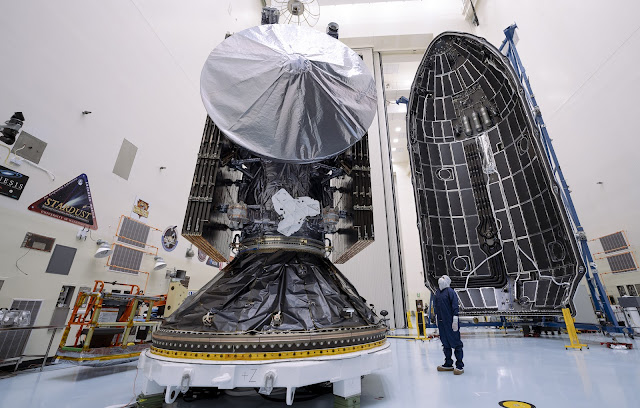Expedition 71-72: New Crew Photos | International Space Station
The 11-member Expedition 72 crew poses for a portrait aboard the International Space Station's Harmony module. In the front row (from left) are, NASA astronauts Butch Wilmore, Nick Hague, and Matthew Dominick, and Roscosmos cosmonaut Aleksandr Gorbunov (Russia), and NASA astronaut Suni Williams. In the back are, NASA astronaut Jeanette Epps, Roscosmos cosmonaut Aleksandr Grebenkin (Russia), NASA astronaut Mike Barratt, Roscosmos cosmonaut Ivan Vagner (Russia), NASA astronaut Don Pettit, and Roscosmos cosmonaut Alexey Ovchinin (Russia).
The four crew members that make up the SpaceX Crew-8 mission aboard the International Space Station are pictured in the vestibule in between the Harmony module's space-facing port and the SpaceX Dragon Endeavour spacecraft. From top to bottom are, NASA astronauts Jeanette Epps, Mike Barratt, and Matthew Dominick, and Roscosmos cosmonaut Alexander Grebenkin (Russia).
Roscosmos cosmonaut and Expedition 72 Flight Engineer Alexander Grebenkin of Russia is pictured inside the vestibule between the SpaceX Dragon Endeavour spacecraft and the Harmony module's space-facing port on the International Space Station.
Expedition 72 Flight Engineers (from left) Matthew Dominick and Mike Barratt, both NASA astronauts, pose for a portrait inside the SpaceX Dragon Endeavour spacecraft docked to the Harmony module's space-facing port on the International Space Station. Dominick and Barratt appear next to their mission's insignia, SpaceX Crew-8, alongside the insignias of four other missions that have launched to space aboard Dragon Endeavour.
NASA astronaut and Expedition 72 Flight Engineer Jeanette Epps poses for a portrait inside the SpaceX Dragon Endeavour spacecraft docked to the Harmony module's space-facing port on the International Space Station. Epps points to her mission's insignia, SpaceX Crew-8, alongside the insignias of four other missions that have launched to space aboard Dragon Endeavour.
Expedition 72 Flight Engineers (from left) Don Pettit and Mike Barratt, both NASA astronauts, pose for a portrsit together aboard the International Space Station's Destiny laboratory module.
NASA astronaut and Expedition 71 Flight Engineer Suni Williams celebrates her birthday during International Talk Like a Pirate Day aboard the International Space Station. Sitting on the Unity module's gallery is a pair of strawberry cakes for her and crewmates to enjoy. Items are attached to the galley using tape and velcro to keep them from flying away in the microgravity environment.
NASA astronauts Suni Williams and Butch Wilmore, both Expedition 71 Flght Engineers, make pizza aboard the International Space Station's galley located inside the Unity module. Items are attached to the galley using tape and velcro to keep them from flying away in the microgravity environment.
Three NASA astronauts and one Roscosmos cosmonaut representing NASA’s SpaceX Crew-8 are nearing the end of a seven-month mission and are waiting for NASA and SpaceX to announce their return to Earth time and date, pending weather. Dragon Endeavour Commander Matthew Dominick is poised to lead Pilot Mike Barratt with Mission Specialists Jeanette Epps and Alexander Grebenkin of Russia back to Earth inside Dragon with a splashdown off the coast of Florida. The quartet has been packing cargo and personal items inside the spacecraft for several days and spent the end of the day Friday reviewing emergency equipment.
Expedition 72 Updates:
https://blogs.nasa.gov/spacestation/
Expedition 72 Crew
Station Commander: Suni Williams
Roscosmos (Russia): Alexander Grebenkin, Alexey Ovchinin, Ivan Vagner, Aleksandr Gorbunov
NASA: Matthew Dominick, Mike Barrett, Jeanette Epps, Butch Wilmore, Don Pettit, Nick Hague
An international partnership of space agencies provides and operates the elements of the International Space Station (ISS). The principals are the space agencies of the United States, Russia, Europe, Japan, and Canada. The ISS has been the most politically complex space exploration program ever undertaken.
Learn more about the important research being operated on Station:
https://www.nasa.gov/iss-science
For more information about STEM on Station:
https://www.nasa.gov/stemonstation
Science, Technology, Engineering, Math (STEM)
Image Credit: NASA's Johnson Space Center (JSC)
Image Date: Sept. 9-Oct. 1, 2024
#NASA #Space #ISS #Science #SpaceXCrew8 #SpaceX #CrewDragonSpacecraft #Astronauts #Cosmonauts #Russia #Россия #Roscosmos #Роскосмос #HumanSpaceflight #InternationalCooperation #CCP #Expedition71 #Expedition72 #UnitedStates #STEM #Education











































